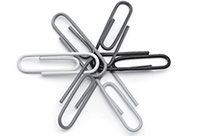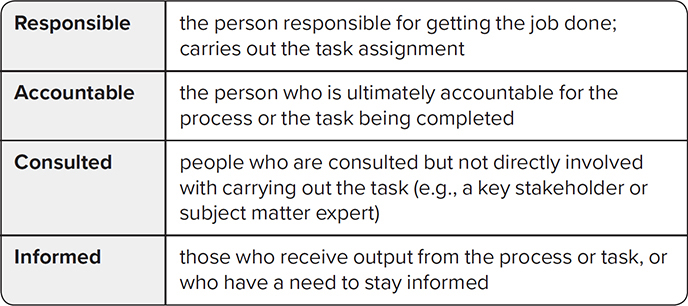
22
ENSURE ROLE CLARITY
Provide the Context and Permission
All the world’s a stage, and all the men and women merely players.
—SHAKESPEARE
We don our work costumes and act our parts at the office. While I urge people to be their authentic selves rather than assumed characters, bringing out the best in people requires that they know what is expected and the limits of their authority to enact it. I’ve seen clients who want to do more but fear they will be seen as grabbing power or overstepping their role. Staff on the front line sometimes hold themselves back from generating immediate, creative solutions, concerned they will be rebuked for breaking established practices.
According to Gallup’s 2017 State of the American Manager Report, based on a study of 2.5 million teams in 195 countries, role clarity leads to success and stress reduction and is therefore one of the most sought-after ingredients for team effectiveness. Setting specific objectives allows people to manage their time and direct their focus, and it is especially important in small businesses or in mission-driven organizations where staff can take on entirely too much work and risk burning out. The quality of relationships is undercut when there’s role confusion. The managers I coach often say, “What do you mean there’s ‘low role clarity’? They all have their job descriptions!” Job descriptions are a requirement but are insufficient as they are often the document against which staff were recruited rather than a defined role on a team that continually needs to be refined.
Organizational design starts with charts and job titles. Once the positions are populated with real people, their personalities don’t easily fit into a box. That’s usually when I am called, to do the “psychological clean-up.” It’s human nature to want to put our personal touch on a role, and many times this imbues work with greater meaning. However, too much modification either by the employee or the manager leads to role slippage. Suddenly, the limits of my job have shifted and it impacts yours, and we both aren’t sure who’s responsible for what. Tempers can flare: “Who does he think he is?” Paranoid feelings can set in: “Why is my job getting smaller? Are they preparing to fire me?” Whenever possible, be unambiguous about each person’s role and the manager’s role.
You can’t imagine (or maybe you can) how many of my clients aren’t sure who their manager is! There’s the person who is named as their supervisor, and then there’s the guy who acts like their boss—and the directives are not always the same. In a matrixed organization this gets even more mixed up. For example, Sally sells high-end sports cars in Chicago and submits her revenues to the manager in charge of Midwest operations, but she attends the meetings led by the luxury division. The regional manager tells her to push sales this month as it is year-end. Meanwhile, the luxury division head has told Sally not to close deals until the next quarter. He’s trying to generate a sense of scarcity. He’s planning on hiking up the price. See Sally’s head explode. Keep the “Sallys” in your company sane. Be clear about what’s expected.
THIS IS FOR YOU IF
• The work product your team presents misses the mark.
• Deadlines slip, and details fall through the cracks.
• “It’s not my job” is an excuse not to pitch in.
• Where to start just isn’t obvious and “Who do I call?” isn’t clear.
TAKE ACTION
![]() End your team meetings with clear action steps and assign specific people to be responsible. Include a due date.
End your team meetings with clear action steps and assign specific people to be responsible. Include a due date.
![]() When launching a new project, invest the time now to save time in the future. Hold a kickoff meeting at which you review what needs to be done, when, and by whom. If there will be overlapping responsibilities, discuss who will take the lead.
When launching a new project, invest the time now to save time in the future. Hold a kickoff meeting at which you review what needs to be done, when, and by whom. If there will be overlapping responsibilities, discuss who will take the lead.
![]() Ensure that the expectations of each role are understood by both the “role-owner” and the other team members. Consider creating cheat sheets of “Who to call if. . . .”
Ensure that the expectations of each role are understood by both the “role-owner” and the other team members. Consider creating cheat sheets of “Who to call if. . . .”
![]() Set up RACI charts: Bring the group together when launching a project, or as a review for ongoing work and fill in the form below. Make sure everyone shares their charts to eliminate ambiguity about who is ultimately accountable for a task, as this is not necessarily the same as the person who is responsible. Colleagues who need to be consulted (e.g., included in communications that require a response) are often confused with those who just need to be kept informed. Reduce email clutter and confusion by agreeing in advance who needs to be included in what correspondence.
Set up RACI charts: Bring the group together when launching a project, or as a review for ongoing work and fill in the form below. Make sure everyone shares their charts to eliminate ambiguity about who is ultimately accountable for a task, as this is not necessarily the same as the person who is responsible. Colleagues who need to be consulted (e.g., included in communications that require a response) are often confused with those who just need to be kept informed. Reduce email clutter and confusion by agreeing in advance who needs to be included in what correspondence.

![]() Try Ken Blanchard’s suggestion in The New One Minute Manager to “make sure each goal is written on a separate piece of paper and takes no more than a minute to read” so that staff know exactly what is expected.
Try Ken Blanchard’s suggestion in The New One Minute Manager to “make sure each goal is written on a separate piece of paper and takes no more than a minute to read” so that staff know exactly what is expected.
![]() If you are one of two supervisors in a matrixed reporting structure, set aside time to meet with the other boss and your direct report so that you can align expectations.
If you are one of two supervisors in a matrixed reporting structure, set aside time to meet with the other boss and your direct report so that you can align expectations.
![]() For people transitioning roles within a company, be clear on the time when one role is complete and the new one has begun.
For people transitioning roles within a company, be clear on the time when one role is complete and the new one has begun.
![]() Avoid secret workarounds that ignore official policy or undermine the person assigned to a task. It’s tempting to allow your favorites, or high performers, to have a little more responsibility. If circumstances allow for a change in role, be transparent about it rather than creating unnecessary confusion and competition.
Avoid secret workarounds that ignore official policy or undermine the person assigned to a task. It’s tempting to allow your favorites, or high performers, to have a little more responsibility. If circumstances allow for a change in role, be transparent about it rather than creating unnecessary confusion and competition.
KEEP IN MIND
• If you are launching a new initiative and haven’t yet defined role expectations, say, “There are no clear guidelines at this time.” This gives staff permission to experiment and take ownership of their outcomes.
• Your intentions may be positive, but if you expand an employee’s responsibility without communicating this more broadly, you can damage your reputation and the person you are trying to help.
